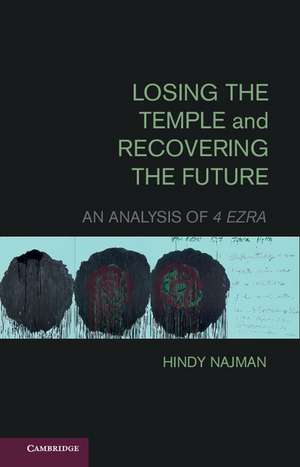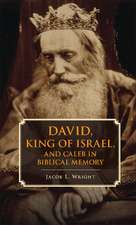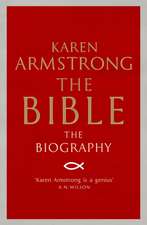Losing the Temple and Recovering the Future: An Analysis of 4 Ezra
Autor Hindy Najmanen Limba Engleză Hardback – 20 apr 2014
Preț: 671.27 lei
Preț vechi: 780.54 lei
-14% Nou
Puncte Express: 1007
Preț estimativ în valută:
128.44€ • 134.47$ • 106.28£
128.44€ • 134.47$ • 106.28£
Carte tipărită la comandă
Livrare economică 05-19 aprilie
Preluare comenzi: 021 569.72.76
Specificații
ISBN-13: 9781107006188
ISBN-10: 110700618X
Pagini: 203
Ilustrații: 5 colour illus.
Dimensiuni: 144 x 222 x 21 mm
Greutate: 0.39 kg
Editura: Cambridge University Press
Colecția Cambridge University Press
Locul publicării:New York, United States
ISBN-10: 110700618X
Pagini: 203
Ilustrații: 5 colour illus.
Dimensiuni: 144 x 222 x 21 mm
Greutate: 0.39 kg
Editura: Cambridge University Press
Colecția Cambridge University Press
Locul publicării:New York, United States
Cuprins
Preface; 1. Reboot; 2. The past and future Ezra; 3. The memory of scripture; 4. Re-centering the world; 5. Radical hope and the revitalization of scripture.
Recenzii
'This remarkable book is a brilliant piece of research, beautifully written and documented, which reveals to the reader the strategies adopted by the writer of 4 Ezra to restore hope after the destruction of the Temple. With the precision, clarity, and philosophical sophistication that characterize all of her writings, Hindy Najman articulates her analysis of the transformations of ancient Judaism in the wake of the destruction. A must-read for everybody interested in Second Temple Judaism.' Florentino García-Martínez, Katholieke Universiteit Leuven
'Hindy Najman's new book on 4 Ezra offers a compelling reading of this important apocalypse. It provides new insights about all aspects of 4 Ezra. I found the interpretation of the final vision, in which Ezra rewrites the Torah, particularly illuminating. It is no small achievement to do justice to this remarkable but difficult passage. Finally, I would note that Najman's book is beautifully composed, truly a pleasure to read.' Martha Himmelfarb, Princeton University, New Jersey
'Najman's study approaches 4 Ezra from an entirely new angle. Through careful examination of the text itself (relying on a new translation of the Syriac version), she investigates in detail specific reworkings of biblical and midrashic material found in 4 Ezra, while also exploring the book's connections to other contemporaneous writings. Familiar themes and motifs here take on a whole new significance thanks to her innovative approach. In the end, however, Najman's book is about far more than 4 Ezra itself. Its ultimate subject is the whole enterprise of understanding anew the nature of divine revelation following the loss of the temple and the dramatic change that this effort brought about in later Judaism.' James Kugel, author of How to Read the Bible
'Hindy Najman's new book opens up breathtaking new perspectives on exile, destruction, and the transformation of revelation, reorienting our understanding of ancient Jewish literature and experience. In the process, she recovers the special significance of 4 Ezra, not just for specialists in so-called pseudepigrapha, but also for readers interested in religion, literature, interpretation, and the creative power of memory.' Annette Yoshiko Reed, University of Pennsylvania
'… a thought-provoking work stimulating reflections on a number of time-honoured questions in the study of late Second Temple Jewish literature in general and in the study of 4 Ezra in particular.' Anders Klostergaard Petersen, Journal for the Study of Judaism
'Reading Hindy Najman's Losing the Temple and Recovering the Future: An Analysis of 4 Ezra is a privilege and an education. The book is a must-read for scholars of Second Temple Judaism, early rabbinic Judaism and early Christianity.' C. Leroy, Ephemerides Theologicae Lovanienses
'Hindy Najman's new book on 4 Ezra offers a compelling reading of this important apocalypse. It provides new insights about all aspects of 4 Ezra. I found the interpretation of the final vision, in which Ezra rewrites the Torah, particularly illuminating. It is no small achievement to do justice to this remarkable but difficult passage. Finally, I would note that Najman's book is beautifully composed, truly a pleasure to read.' Martha Himmelfarb, Princeton University, New Jersey
'Najman's study approaches 4 Ezra from an entirely new angle. Through careful examination of the text itself (relying on a new translation of the Syriac version), she investigates in detail specific reworkings of biblical and midrashic material found in 4 Ezra, while also exploring the book's connections to other contemporaneous writings. Familiar themes and motifs here take on a whole new significance thanks to her innovative approach. In the end, however, Najman's book is about far more than 4 Ezra itself. Its ultimate subject is the whole enterprise of understanding anew the nature of divine revelation following the loss of the temple and the dramatic change that this effort brought about in later Judaism.' James Kugel, author of How to Read the Bible
'Hindy Najman's new book opens up breathtaking new perspectives on exile, destruction, and the transformation of revelation, reorienting our understanding of ancient Jewish literature and experience. In the process, she recovers the special significance of 4 Ezra, not just for specialists in so-called pseudepigrapha, but also for readers interested in religion, literature, interpretation, and the creative power of memory.' Annette Yoshiko Reed, University of Pennsylvania
'… a thought-provoking work stimulating reflections on a number of time-honoured questions in the study of late Second Temple Jewish literature in general and in the study of 4 Ezra in particular.' Anders Klostergaard Petersen, Journal for the Study of Judaism
'Reading Hindy Najman's Losing the Temple and Recovering the Future: An Analysis of 4 Ezra is a privilege and an education. The book is a must-read for scholars of Second Temple Judaism, early rabbinic Judaism and early Christianity.' C. Leroy, Ephemerides Theologicae Lovanienses
Notă biografică
Descriere
This book explores the Jewish community's response to the destruction of the Second Temple in 70 CE.











